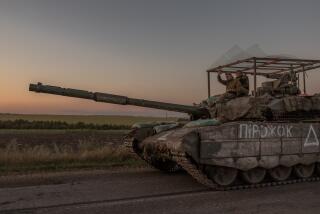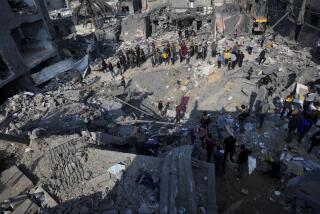U.S. Military Finding Key Deficiencies Amid Victory : Lessons: Much went right, planners say. But there are problems with fast, long-range deployment.
- Share via
WASHINGTON — In the aftermath of the sweeping Persian Gulf War triumph, U.S. military leaders now confront a formidable new challenge--the reform of a victorious army.
One of the cruel ironies of history is that nations tend to learn much less from military victories than from defeats.
But senior military planners, fearing an outbreak of arrogance and complacency in the armed services, have begun a coldblooded analysis of the lessons of the Gulf War. It already has yielded a picture not wholly positive.
For all its successes, the war highlighted critical deficiencies in America’s military, particularly in its ability to quickly deploy large forces far from U.S. shores. These problems could grow far worse as defense spending and the size of the armed forces shrink over the next five years.
Much went right, from the smooth functioning of the joint command structure, to the impressive performance of a new generation of weapons, to the brilliant execution of an ambitious campaign plan, officials said.
But the effort was aided by a number of fortunate circumstances unlikely ever to be repeated, among them the 163 days that the allies had to build up their forces, the ability to operate from sophisticated Saudi Arabian seaports and airfields, the benefits of a battlefield with no natural cover and Iraqi President Saddam Hussein’s astonishing military incompetence.
“People are already drawing lessons from this war, and almost invariably they will be wrong,” said Roger Spiller, director of the Combat Studies Institute at the Army’s Command and General Staff College.
Spiller, one of the Army’s leading theorists, fears that the Persian Gulf War, while laying to rest the ghost of Vietnam, will give birth to a new orthodoxy in the American military, one just as dangerous and debilitating as the last one.
The military should be asking itself difficult, provocative questions now, not engaging in an orgy of self-congratulation, Spiller and other senior military officials said.
“Like this one,” Spiller said. “What do we call this war? Persian Gulf War I?”
Other senior officials noted that U.S. intelligence agencies consistently overestimated Iraqi capabilities and guessed wrong about Iraqi intentions.
Intelligence analysts, embarrassed by past failures to predict crises like the Iranian revolution, have now leaned too far in the other direction, some officials have complained, seeing threats where they don’t exist and constantly “crying wolf” about potential enemies.
As a result, the United States may have overbuilt its force in the Persian Gulf, which helped bring the war to a speedy end but left many officials concerned about the quality of intelligence analysis.
The intelligence analysts’ conservative approach also understated the true extent of the damage wreaked by the allied air campaign against the Iraqi army, which could not be assessed merely by counting the damaged hulks of tanks on satellite photographs, officials said.
In numerous interviews with senior military officers and Pentagon officials, during and immediately after the fighting, one overriding lesson was cited: The importance of what the military calls “unity of command.”
Since the end of the Vietnam War, the military has consolidated its command structure into a simple, lean system with clear lines of authority. The chairman of the Joint Chiefs of Staff, Gen. Colin L. Powell, is the unchallenged senior military leader of the country, reporting directly to the President. Under his direct control are the theater commanders, including the four-star head of Central Command, Gen. H. Norman Schwarzkopf.
“The principal lesson we learned from Vietnam . . . is that there is a right way and a wrong way to employ the military to solve a political problem. (President Bush) chose the right way. It’s not an unconstrained approach. It’s setting clear goals and objectives and giving the military the tools to accomplish them,” said one active-duty general.
Bush gave the military three clear objectives: eject the Iraqi army from Kuwait, destroy Iraq’s offensive military power, including its nuclear and chemical weapons capabilities, and limit allied and civilian casualties.
Bush approved the plans presented by the military but offered virtually no opinions on how the campaign should be conducted.
Schwarzkopf said Wednesday, “I’m very thankful for the fact that the President of the United States has allowed the United States military and the coalition military to fight this war exactly as it should have been fought, and the President in every case has taken our guidance and our recommendations to heart.”
The second most important lesson, officials said, is that the effects of air, land and sea power applied together in a coherent way can overwhelm a force that is numerically stronger.
Pentagon officials asserted that the Desert Storm operation will put to rest the debate over whether air power alone can win a war.
“You can never defeat a force from the air,” a senior Army officer said. “You can degrade it, pummel it, disorganize it. But you can’t kill it. Air power could have brought surrender, but not defeat.”
Even Air Force officials acknowledge that the large land force was needed to block an Iraqi advance into Saudi Arabia. Without the Army, one Saudi-based combat pilot said last fall, “We could have come back to our ready room (from an air mission) and found the Iraqis eating our lunch.”
The day the fighting ended, senior Army aides presented to Army Chief of Staff Carl E. Vuono their first observations on the operation. Such an initial review of a just-concluded operation is called a “hot wash.” It is the first step in the military’s formal “lessons learned” process of incorporating the wisdom gleaned from experience.
Desert Storm proved a number of the military’s “eternal verities” and disclosed some weaknesses in the current force, the planners said. Among the long-held beliefs reinforced by the latest experience:
* The proper application of technology in combat can tip the scales in favor of a smaller force. A small number of highly sophisticated systems--like the F-117 Stealth fighter--can be vastly more valuable than a large number of cheaper, less capable weapons.
* The army with the superior battlefield intelligence--whether gathered by satellites, aircraft, drones or special forces on the ground--has a decisive advantage over a force that is “blind.”
* Continued heavy investment in realistic training and high rates of readiness of ground, air and sea forces is essential. If a military loses its edge, it will not be able to regain it quickly enough in a crisis.
* The key to success in war, as the ancient Chinese strategist Sun Tzu wrote, is not to defeat the enemy’s forces, but to defeat his strategy. Hussein tried to lure the allied army into his sturdy defenses. Instead, allied air forces practically obliterated the defensive lines and the troops manning them and then swung far around them in an enveloping maneuver.
Among the possible weaknesses the study discerns:
Third World crises can erupt with no warning, and developing countries can fight high-intensity land wars, with advanced electronic and missile technology.
* The U.S. military’s ability to project power over long distances on short notice is questionable. The nation’s military airlift and sea-lift capabilities are inadequate and in need of urgent attention.
* Large numbers of reserves and National Guard troops will be needed in future crises. While the required specialties are now available in adequate numbers, it takes too long to activate reserves and get them to trouble spots. Future guard and reserve recruitment is also a major concern of military planners.
* Battlefield obstacles such as Iraq’s antitank berms, ditches and minefields are effective only if covered by intense artillery fire or air power. Allied strategy in Europe has long depended heavily on throwing such obstacles in the way of an advancing Soviet tank army; that strategy is now under review.
Marvin Feuerwerger, military analyst at the Washington Institute for Near East Policy, said that America’s potential enemies will learn one very valuable lesson from the Gulf War: If you’re going to attack, do it quickly.
“We had a major vulnerability in getting a sufficient force out there in a timely way,” he said. “For the first three months, we were in very bad shape if (Hussein) had decided to move.”
Schwarzkopf highlighted the problem in his briefing about the campaign last week, saying that the press played a pivotal role in convincing the Iraqis that the American force was larger and more capable than it actually was.
To speed deployment of U.S. troops to the region if a new crisis erupts, defense officials have already begun to negotiate with governments in the Persian Gulf region for permanent basing arrangements and the right to put large stocks of war-fighting equipment there.
Over the next five years, these and similar deals will replace the expensive and politically vulnerable network of overseas bases that the U.S. military now relies on to project power around the globe, officials have said.
One of the innovations of the war was the way in which computers were used to plan highly complex, tactical and logistic operations. Never before has a military command been able to coordinate 2,500 or more air sorties a day, involving air forces of several different nations, over a single theater.
All air operations were the province of a single officer, Air Force Lt. Gen. Charles E. Horner, who created a “joint air tasking order” for more than 2,000 Air Force, Navy, Marine Corps and Army aircraft in the theater, as well as hundreds more from the Saudi, French, British and Kuwaiti air forces.
“He was able to coordinate that better with Saudis and British than the (U.S.) Navy and Air Force could coordinate with each other in the raid on Libya just five years ago,” Feuerwerger said.
“It’s an extraordinary lesson, and provides a tremendous capability for all future battles,” he added. “Never before could we have mounted 2,500 sorties a day without all sorts of planes crashing into each other.”
Likewise, the logistic requirements of moving two full Army corps far to the west of Kuwait to be in position for their wheeling maneuver required a Herculean computer-aided effort, officials said.
The Army found it was short of heavy-equipment transporters to move tanks and other armored vehicles to their staging area, so it had to scramble to buy them from Saudi Arabia, Egypt and Germany, officials said. Future budgets will contain requests for more such trucks, they added.
But Spiller insisted that America’s greatest advantage was not its superior hardware, but its leaders.
“When you compare the two sides, the starkest difference was not technological, but human,” the Army theoretician said. “I think of warfare as a human problem, not a mechanical one. Think about the leadership of the two countries, and not just at the political level, but on the battlefield, from Schwarzkopf on down.
“If you want to find the origin of victory, that just might be it,” he said.
LESSONS OF WAR
The victory in the Gulf War has already yielded some lessons . Among them: STRENGTHS:
* Smooth functioning of joint command structure.
* New generation of weapons performed well.
* Well-integrated air, land and sea power can overwhelm numerically stronger force.
* Side with superior intelligence has decisive advantage.
* Continued heavy investment in training is essential.
* Concentrate on defeating an enemy’s strategy as well as its forces.
* Computers were effectively used to plan complex tactical and logistic operations.
WEAKNESSES:
* Deploying larges forces far from U.S. quickly enough.
* Overestimation of Iraqi capabilities.
* Maintaining ability to activate and deploy adequate reserves.
More to Read
Sign up for Essential California
The most important California stories and recommendations in your inbox every morning.
You may occasionally receive promotional content from the Los Angeles Times.










